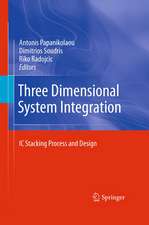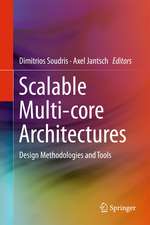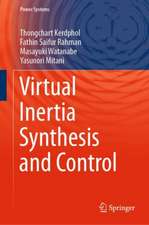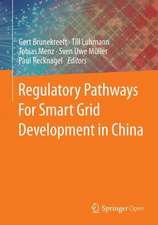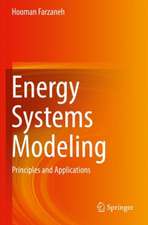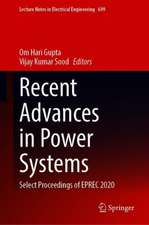IoT for Smart Grids: Design Challenges and Paradigms: Power Systems
Editat de Kostas Siozios, Dimitrios Anagnostos, Dimitrios Soudris, Elias Kosmatopoulosen Limba Engleză Hardback – 5 dec 2018
This book explains the fundamentals of control theory for Internet of Things (IoT) systems and smart grids and its applications. It discusses the challenges imposed by large-scale systems, and describes the current and future trends and challenges in decision-making for IoT in detail, showing the ongoing industrial and academic research in the field of smart grid domain applications.
It presents step-by-step design guidelines for the modeling, design, customisation and calibration of IoT systems applied to smart grids, in which the challenges increase with each system’s increasing complexity. It also provides solutions and detailed examples to demonstrate how to use the techniques to overcome these challenges, as well as other problems related to decision-making for successful implementation. Further, it anaylses the features of decision-making, such as low-complexity and fault-tolerance, and uses open-source and publicly available software tools to show readers how they can design, implement and customise their own system control instantiations.
This book is a valuable resource for power engineers and researchers, as it addresses the analysis and design of flexible decision-making mechanisms for smart grids. It is also of interest to students on courses related to control of large-scale systems, since it covers the use of state-of-the-art technology with examples and solutions in every chapter. And last but not least, it offers practical advice for professionals working with smart grids.
Din seria Power Systems
- 18%
 Preț: 953.13 lei
Preț: 953.13 lei - 18%
 Preț: 783.98 lei
Preț: 783.98 lei - 20%
 Preț: 1002.48 lei
Preț: 1002.48 lei - 18%
 Preț: 1021.86 lei
Preț: 1021.86 lei - 18%
 Preț: 897.65 lei
Preț: 897.65 lei - 18%
 Preț: 788.72 lei
Preț: 788.72 lei - 18%
 Preț: 734.27 lei
Preț: 734.27 lei - 18%
 Preț: 902.36 lei
Preț: 902.36 lei -
 Preț: 563.51 lei
Preț: 563.51 lei - 18%
 Preț: 955.08 lei
Preț: 955.08 lei - 18%
 Preț: 946.87 lei
Preț: 946.87 lei - 18%
 Preț: 950.52 lei
Preț: 950.52 lei - 18%
 Preț: 949.23 lei
Preț: 949.23 lei - 15%
 Preț: 641.85 lei
Preț: 641.85 lei - 18%
 Preț: 1116.26 lei
Preț: 1116.26 lei - 18%
 Preț: 961.10 lei
Preț: 961.10 lei - 18%
 Preț: 1380.78 lei
Preț: 1380.78 lei - 15%
 Preț: 639.59 lei
Preț: 639.59 lei - 15%
 Preț: 641.03 lei
Preț: 641.03 lei - 18%
 Preț: 2497.51 lei
Preț: 2497.51 lei - 18%
 Preț: 957.62 lei
Preț: 957.62 lei - 18%
 Preț: 1229.91 lei
Preț: 1229.91 lei - 15%
 Preț: 643.34 lei
Preț: 643.34 lei - 18%
 Preț: 957.09 lei
Preț: 957.09 lei - 18%
 Preț: 1231.47 lei
Preț: 1231.47 lei - 15%
 Preț: 698.30 lei
Preț: 698.30 lei - 18%
 Preț: 953.20 lei
Preț: 953.20 lei - 15%
 Preț: 640.88 lei
Preț: 640.88 lei - 15%
 Preț: 634.18 lei
Preț: 634.18 lei - 18%
 Preț: 955.08 lei
Preț: 955.08 lei - 18%
 Preț: 1241.73 lei
Preț: 1241.73 lei - 18%
 Preț: 952.09 lei
Preț: 952.09 lei - 18%
 Preț: 946.55 lei
Preț: 946.55 lei - 18%
 Preț: 961.86 lei
Preț: 961.86 lei - 18%
 Preț: 944.19 lei
Preț: 944.19 lei - 18%
 Preț: 1110.72 lei
Preț: 1110.72 lei - 15%
 Preț: 642.03 lei
Preț: 642.03 lei - 15%
 Preț: 636.12 lei
Preț: 636.12 lei - 18%
 Preț: 1054.99 lei
Preț: 1054.99 lei - 15%
 Preț: 639.90 lei
Preț: 639.90 lei - 18%
 Preț: 957.32 lei
Preț: 957.32 lei - 18%
 Preț: 1235.57 lei
Preț: 1235.57 lei - 18%
 Preț: 959.19 lei
Preț: 959.19 lei
Preț: 787.29 lei
Preț vechi: 960.11 lei
-18% Nou
Puncte Express: 1181
Preț estimativ în valută:
150.68€ • 162.65$ • 126.35£
150.68€ • 162.65$ • 126.35£
Carte tipărită la comandă
Livrare economică 19 aprilie-03 mai
Preluare comenzi: 021 569.72.76
Specificații
ISBN-13: 9783030031695
ISBN-10: 3030031691
Pagini: 259
Ilustrații: XV, 282 p. 115 illus., 94 illus. in color.
Dimensiuni: 155 x 235 x 17 mm
Greutate: 0.59 kg
Ediția:1st ed. 2019
Editura: Springer International Publishing
Colecția Springer
Seria Power Systems
Locul publicării:Cham, Switzerland
ISBN-10: 3030031691
Pagini: 259
Ilustrații: XV, 282 p. 115 illus., 94 illus. in color.
Dimensiuni: 155 x 235 x 17 mm
Greutate: 0.59 kg
Ediția:1st ed. 2019
Editura: Springer International Publishing
Colecția Springer
Seria Power Systems
Locul publicării:Cham, Switzerland
Cuprins
IoT for Smart Grids - Design Challenges and Paradigms.- Part I: Fundamental Topics and Technologies for IoT Systems Targeting Smart-Grid Domain.- Mastering the challenges of changing energy systems: The Smart-Grid Concept.- Edge Computing for Smart Grid: An Overview on Architectures and Solutions.- Smart-Grid Modelling and Simulation.- Communication Protocols for the IoT-based Smart Grid.- Smart Grid Hardware Security.- Edge Computing and Efficient Resource Management forintegration of video devices in Smart Grid deployments.- Solar Energy Forecasting in the Era of IoT Enabled Smart Grids.- Data Analytic for Improving Operations and Maintenance in Smart-Grid Environment.- On Accelerating Data Analytics: An Introduction to the Approximate Computing Technique.- Part II: Case Studies about Computerized Monitor and Control of Energy Systems.- Towards plug&play smart thermostats for building’s heating/cooling control.
Notă biografică
Prof. Kostas Siozios received his Diploma, Master’s and Ph.D. degrees in Electrical and Computer Engineering from the Democritus University of Thrace, Greece, in 2001, 2003 and 2009, respectively. Currently, he is an Assistant Professor at the Department of Physics, Aristotle University of Thessaloniki. His research interests include CAD algorithms, cyberphysical systems, low-power reconfigurable architectures and parallel architectures. He has published more than 110 papers in international journals and conferences, and has contributed to 5 books published by Kluwer and Springer. In recent years he has been a principal investigator in numerous research projects funded by the European Commission (EC), European Space Agency (ESA), as well as the Greek Government and Industry.
Dimitrios Anagnostos was born in Greece in 1988. He received B.E. and M.E. degrees from the National Technical University of Athens (NTUA), Greece, in 2012. He iscurrently pursuing his Ph.D. in Electrical Engineering at NTUA in cooperation with Katholieke Universiteit Leuven (KUL). His main areas of research interest are photovoltaic modeling for energy yield assessment and forecasting, and advanced methods of design space exploration. Mr. Anagnostos is a member of the Technical Chamber of Greece.
Prof. Dimitrios Soudris received his Diploma and Ph.D. degree in Electrical and Computer Engineering from the University of Patras, Greece, in 1987 and 1992, respectively. He was a Professor at the Department of Electrical and Computer Engineering, Democritus University of Thrace for 13 years and is currently working as an Associate Professor at the School of ECE at the National Technical University of Athens, Greece. His research interests include embedded systems design, reconfigurable architectures, network-on-chip architectures and low-power VLSI design. He has published more than 350 papers in international journals and conferences, and is the author or editor of eight books published by Kluwer and Springer. He is the Head of Embedded Systems group consisting of four senior investigators (postdocs), eight Ph.D. students and a number of M.Sc. students. He is leader and principal investigator in numerous research projects funded by the European Commission, ENIAC-JU, European Space Agency and the Greek and German Government and Industry.
Prof. Elias Kosmatopoulos received Diploma, M.Sc. and Ph.D. degrees from the Technical University of Crete, Greece, in 1990, 1992, and 1995, respectively. He is a Professor at the Department of Electrical and Computer Engineering at the Democritus University of Thrace, Greece. He has been an Assistant Professor at the Department of Production Engineering and Management, Technical University of Crete (TUC), Greece and Deputy Director of the Dynamic Systems and Simulation Laboratory at TUC. Prior to joining TUC, he was Research Associate/Assistant Professor at the Department of Electrical Engineering-Systems, University of Southern California (USC) and a Postdoctoral Fellow at the Department of Electrical & Computer Engineering, University of Victoria, B.C., Canada. Prof. Kosmatopoulos’ research interests are in the areas of nonlinear and adaptive control, robotics, energy-efficient buildings and intelligent transportation systems.
Textul de pe ultima copertă
This book explains the fundamentals of control theory for Internet of Things (IoT) systems and smart grids and its applications. It discusses the challenges imposed by large-scale systems, and describes the current and future trends and challenges in decision-making for IoT in detail, showing the ongoing industrial and academic research in the field of smart grid domain applications.
It presents step-by-step design guidelines for the modeling, design, customisation and calibration of IoT systems applied to smart grids, in which the challenges increase with each system’s increasing complexity. It also provides solutions and detailed examples to demonstrate how to use the techniques to overcome these challenges, as well as other problems related to decision-making for successful implementation. Further, it anaylses the features of decision-making, such as low-complexity and fault-tolerance, and uses open-source and publicly available software tools to show readers how they can design, implement and customise their own system control instantiations.
This book is a valuable resource for power engineers and researchers, as it addresses the analysis and design of flexible decision-making mechanisms for smart grids. It is also of interest to students on courses related to control of large-scale systems, since it covers the use of state-of-the-art technology with examples and solutions in every chapter. And last but not least, it offers practical advice for professionals working with smart grids.
Caracteristici
Shows readers how to implement the IoT in a smart grid environment Includes exercises and worked examples to aid understanding Provides open-source tools on the authors’ website to help readers address simulation and rapid-prototyping tasks


